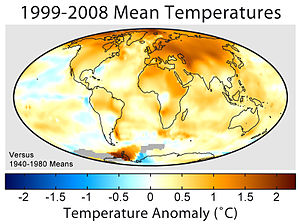 Image via Wikipedia
Image via WikipediaAs global warming accelerates, the world will become not only hotter, flatter, and more crowded but also thirsty, according to a new study that finds 70 percent of counties in the United States may face climate change-related risks to their water supplies by 2050.
One-third of U.S. counties may find themselves at "high or extreme risk," according to the report prepared for the Natural Resources Defense Council by Tetra Tech, a California environmental consulting firm.
"It appears highly likely that climate change could have major impacts on the available precipitation and the sustainability of water withdrawals in future years under the business-as-usual scenario," the study’s authors conclude. "This calculation indicates the increase in risk that affected counties face that water demand will outstrip supplies, if no other remedial actions are taken. To be clear, it is not intended as a prediction that water shortages will occur, but rather where they are more likely to occur."
Those conclusions are based on climate modeling, predicted precipitation, historical drinking water consumption as well as water use by industry and for electrical generation.
It's no surprise that states in the hot and dry West faces the highest risk of water shortages. Arizona, California, Nevada, and Texas top the list, though the study also finds that part of Florida could find itself tapped out.
"As a result, the pressure on public officials and water users to creatively manage demand and supply -- through greater efficiency and realignment among competing uses, and by water recycling and creation of new supplies through treatment -- will be greatest in these regions," the report states. "The majority of the Midwest and Southern regions are considered to be at moderate risk, whereas the Northeast and some regions in the Northwest are at low risk of impacts."
The forecast relies on the continuation of business as usual -- i.e. the nation does not change its water-wasting ways -- and also on federal government data that predicts the U.S. will continue to use thirsty fossil-fuel power plants to generate electricity.
That should whet some appetites for renewable energy sources that use less water and for investment in new water technologies. SOURCE
One-third of U.S. counties may find themselves at "high or extreme risk," according to the report prepared for the Natural Resources Defense Council by Tetra Tech, a California environmental consulting firm.
"It appears highly likely that climate change could have major impacts on the available precipitation and the sustainability of water withdrawals in future years under the business-as-usual scenario," the study’s authors conclude. "This calculation indicates the increase in risk that affected counties face that water demand will outstrip supplies, if no other remedial actions are taken. To be clear, it is not intended as a prediction that water shortages will occur, but rather where they are more likely to occur."
Those conclusions are based on climate modeling, predicted precipitation, historical drinking water consumption as well as water use by industry and for electrical generation.
It's no surprise that states in the hot and dry West faces the highest risk of water shortages. Arizona, California, Nevada, and Texas top the list, though the study also finds that part of Florida could find itself tapped out.
"As a result, the pressure on public officials and water users to creatively manage demand and supply -- through greater efficiency and realignment among competing uses, and by water recycling and creation of new supplies through treatment -- will be greatest in these regions," the report states. "The majority of the Midwest and Southern regions are considered to be at moderate risk, whereas the Northeast and some regions in the Northwest are at low risk of impacts."
The forecast relies on the continuation of business as usual -- i.e. the nation does not change its water-wasting ways -- and also on federal government data that predicts the U.S. will continue to use thirsty fossil-fuel power plants to generate electricity.
That should whet some appetites for renewable energy sources that use less water and for investment in new water technologies. SOURCE


No comments:
Post a Comment